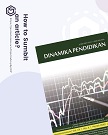Learning Community on Computer-Based Statistics Acceptance for Accounting Students
(1) Universitas Muhammadiyah Sumatera Utara
(2) Universitas Negeri Medan
(3) Universitas Negeri Medan
Abstract
This study aims to examine the influence of the learning community on computer-based statistic acceptance. Acceptability is measured with perceived usefulness variables, perceived ease of use, perceived enjoyment, and reuse intention. This study used quasi-experimental design. To selecting the respondents, researchers used cluster random sampling and a questionnaire to collect the data. Respondents consisted of 207 accounting students of which 86 were engaged in the learning community while 121 were not. One-way ANOVA analysis result showed that students who participated in the learning community have better computer-based statistic acceptance than the students who did not. The learning community was found to be able to facilitate the transfer of knowledge among students more freely than in the classroom. Further research can consider true-experimental design or lab experiment with more rigorous manipulation for controlling bias from another variable that may consist.
Keywords
Full Text:
PDFReferences
Ajzen, I. (1985) From intentions to actions: A theory of planned behavior. Action control (pp. 11-39). Springer Berlin Heidelberg. DOI: https://doi.org/10.1007/978-3-642-69746-3_2
Al-Hawamdeh, S. (2003). Knowledge management: cultivating knowledge professionals. Oxford, UK: Chandos Publishing
Alavi, M., & Leidner, D. E. (2001) Knowledge management and knowledge management systems: Conceptual foundations and research issues. MIS quarterly, 25(1): 107-136. DOI: 10.2307/3250961
Balyer, A., Karatas, H., & Alci, B. (2015). School principals’ roles in establishing collaborative professional learning communities at schools. Procedia-Social and Behavioral Sciences, 197, 1340-1347. DOI: https://doi.org/10.1016/j.sbspro.2015.07.387
Cavanagh, P., Evans, J., Fiatarone, M., Hagberg, J., McAuley, E., & Startzell, J. (1998). Exercise and physical activity for older adults. Med Sci Sports Exerc, 30 (6), 1-29. URL: http://www.unikore.it/phocadownload/userupload/2a12ea0a9a/American%20College%20of%20Sports%20Medicine%201998.pdf
Chapman, C., Ramondt, L., & Smiley, G. (2005). Strong community, deep learning: Exploring the link. Innovations in education and teaching international, 42 (3), 217-230. DOI: https://doi.org/10.1080/01587910500167910
Cooper, D. R., & Schindler, P. S (2001) Business Research Methods. McGraw, New York.
Crawford, Tonia., Peter Roger, & Sally Candin. (2016). The Interactional Consequences of ‘Empowering Discourse’ in Intercultural Patient Education. Patient Education and Counseling. Vol. 100, Issue 3, (March 2017): 495-500. DOI: https://doi.org/10.1016/j.pec.2016.09.017
Dalkir, Kimiz (2005). Knowledge management in theory and practice. New York: Elsevier.
Datzberger, Simone.(2016). Peacebuilding through non-formal education programmes: a case study from Karamoja, Uganda. International Peacekeeping, 24(2), pp 326-349. DOI: https://doi.org/10.1080/13533312.2016.1214073
Davies, J., & Graff, M. (2005). Performance in e learning: online participation and student grades. British Journal of Educational Technology, 36(4), 657-663. DOI: https://doi.org/10.1111/j.1467-8535.2005.00542.x
Davis, F. D., Bagozzi, R. P., & Warshaw, P. R. (1989) User acceptance of computer technology: a comparison of two theoretical models. Management science, 35(8), 982-1003. DOI: https://doi.org/10.1287/mnsc.35.8.982
DeLone, W. H. & McLean, E. R. (1992) Information Systems Success: the Quest For Dependent Variable. Information Systems Research, 3, 60-95. DOI: https://doi.org/10.1287/isre.3.1.60
DeLone, W. H. & McLean, E. R. (2004) Measuring E-Commerce Success: Applying DeLone & McLean Information Systems Success. International Journal of Electronic Commerce, 9, 31-47. URL: https://www.tandfonline.com/doi/abs/10.1080/10864415.2004.11044317
Dholakia, Utpal M., Richard P. Bagozzi, & Lisa Klein Pearo (2004) A social influence model of consumer participation in network- and small-group-based virtual communities. International Journal of Research in Marketing. Vol 21, (2004): 241-263. DOI: https://doi.org/10.1016/j.ijresmar.2003.12.004
Effiyanti, Tri and Sagala, Gaffar Hafiz (2018) Technostress among teachers: a confirmation of its stressors and antecedent. Int. J. Education Economics and Development, Vol. 9, Issue 2, pp. 134-148. DOI: https://doi.org/10.1504/IJEED.2018.092197
Flood, Barbara & Richard M.S. Wilson. (2008). An exploration of the learning approaches of prospective professional accountants in Ireland. Accounting Forum Vol. 32,p.225-239. DOI: https://doi.org/10.1016/j.accfor.2008.01.001
Fogarty, T. J., Zimmerman, A. B., & Richardson, V. J. (2016). What do we mean by accounting program quality? A decomposition of accounting faculty opinions. Journal of Accounting Education, 36, 16-42. DOI: https://doi.org/10.1016/j.jaccedu.2016.04.001
Gougeon, Laura., Jessie Johnson, & Hannah Morse (2017) Interprofessional collaboration in health care teams for the maintenance of community-dwelling seniors’ health and well-being in Canada: A systematic review of trials. Journal of Interprofessional Education & Practice Vol 7, (2017): 29-27. DOI: https://doi.org/10.1016/j.xjep.2017.02.004
Grant, R. M. (1996) Toward a knowledge-based theory of the firm.Strategic Management Journal, 17(S2): 109-122. DOI: https://doi.org/10.1002/smj.4250171110
Fullan, M. G. (1993). Why teachers must become change agents. Educational leadership, 50 (6), 12-12. URL: http://michaelfullan.ca/wp-content/uploads/2016/06/13396031680.pdf
Hair, J. F., Anderson, R. E., Babin, B. J., & Black, W. C. (2010). Multivariate data analysis: A global perspective (Vol. 7). Upper Saddle River, NJ: Pearson.
Hu, Paul, Patrick Y. K. Chau, Olivia R. Liu Sheng and Kar Yan Tam (1999) Examining the Technology Acceptance Model Using Physcian Acceptance of Telemedicine Technology. Journal of Management Informations Systems. 16 (2): 91-112. DOI: https://doi.org/10.1080/07421222.1999.11518247
Hunt, Jane.A. (1998) Empowering health care professionals: a relationship between primary health care teams and paediatric oncology outreach nurse specialists. European Journal of Oncology Nursing. Vol. 2, Pg 27-33. DOI: https://doi.org/10.1016/S1462-3889(98)81258-1
Kaenzig, Rebecca & Rachel Keller. (2012) A comprehensive effort to recruit and retain accounting students. Journal of Accounting Education Vol 29, (2011), pp 315-323. DOI: https://doi.org/10.1016/j.jaccedu.2012.06.008
Kerlinger, F. N. (1986). Fundamentals of behavioral research. New York: Holt, Rinehart, Winston.
Leonardi, P. M. (2017). The social media revolution: Sharing and learning in the age of leaky knowledge. Information and Organization, 27(1), 47-59. DOI: https://doi.org/10.1016/j.infoandorg.2017.01.004
Liu, P., & Liu, J. (2017). Cooperation in the prisoner’s dilemma game on tunable community networks. Physica A: Statistical Mechanics and its Applications, 472, 156-163. DOI: https://doi.org/10.1016/j.physa.2016.12.059
Martin, F., & Ertzberger, J. (2013). Here and now mobile learning: An experimental study on the use of mobile technology. Computers & Education, 68, 76-85. DOI: https://doi.org/10.1016/j.compedu.2013.04.021
Mtika, Mike Mathambo & Matthew Kistler (2017) Contiguous community development. Journal of Rural Studies. Vol. 51, p.83-92. DOI: https://doi.org/10.1016/j.jrurstud.2017.01.018
Nahartyo, Ertambang. (2012). Desain dan Implementasi Riset Eksperimen. Yogyakarta: UPP STIM YKPN.
Nasri, W., & Charfeddine, L. (2012) Factors affecting the adoption of Internet banking in Tunisia: An integration theory of acceptance model and theory of planned behavior. The Journal of High Technology Management Research, 23(1), 1-14. DOI: https://doi.org/10.1016/j.hitech.2012.03.001
Navimipour, N. J. & Charband, Y. (2016). Knowledge sharing mechanisms and techniques in project teams: Literature review, classification, and current trends. Computers in Human Behavior, 62, pp 730-742. DOI: https://doi.org/10.1016/j.chb.2016.05.003
Nguyen, T. H., Charity, I., & Robson, A. (2016). Students’ perceptions of computer-based learning environments, their attitude towards business statistics, and their academic achievement: implications from a UK university. Studies in Higher Education, 41(4), 734-755. DOI: https://doi.org/10.1080/03075079.2014.950562
Nonaka, Ikujiro., & Takeuchi, H. (1995). The knowledge-creating company: How Japanese companies create the dynamics of innovation. Oxford, UK: Oxford university press.
Onwuegbuzie, A. J. (2000) Statistics Anxiety and the Role of Self-Perceptions. Journal of Educational Research 93 (5): 323–30. DOI: https://doi.org/10.1080/00220670009598724
Reinl, L., & Kelliher, F. (2014). The social dynamics of micro-firm learning in an evolving learning community. Tourism Management, 40, 117-125 DOI: https://doi.org/10.1016/j.tourman.2013.05.012
Rizan, Tengku Nor., Tengku Mohamsd Maasum & Nooreiny Maarof (2012) Empowering ESL Readers with Metacognitive Reading Strategies. Procedia-Social and Behavioral Science Vol.69 (2012): 1250-1258. URL: https://core.ac.uk/download/pdf/82105512.pdf
Roca, Juan Carlos; Chao-Min Chiu; Francisco Jose Martinez (2006) Understanding E-Learning Continuance intention: An Extention of the Technology Acceptance Model. Int. J. Human-Computer Studies 64 pp. 683-696. DOI: https://doi.org/10.1016/j.ijhcs.2006.01.003
Sagala, G. H., Zainal, A., & Effiyanti, T. (2017). Attitude Toward Computer-Based Statistics Among Pre-Service Teacher Candidates. Proceedings of MAC 2017, 366.
Samkin, G. & Francis, G. (2008). Introducing a Learning Portfolio in an Undergraduate Financial Accounting Course. Accounting Education Journal, 17(3), pp 233-271. DOI: https://doi.org/10.1080/09639280701577460
Sasao, T., Konomi, S. I., Kostakos, V., Kuribayashi, K., & Goncalves, J. (2017) Community Reminder: Participatory contextual reminder environments for local communities. International Journal of Human-Computer Studies, 102, 41-53. DOI: https://doi.org/10.1016/j.ijhcs.2016.09.001
Sekaran, U., & Bougie, R. (2016). Research methods for business: A skill building approach. John Wiley & Sons.
Seddon P. B. (1997) A Respecification and Extention of the DeLone and McLean Model of IS Success. Information Systems Research, vol. 8, pp 240-253. DOI: https://doi.org/10.1287/isre.8.3.240
Sergiovanni, T. J. (1993). Frames of Leadership. International Journal of Educational Reform, 2(1), 19-26. URL: https://eric.ed.gov/?id=EJ457335
Stanley, Trevor & Stephen Marsden. (2013) Accountancy capstone: Enhancing integration and professional identity. Journal of Accounting Education Vol 31, (2013): 363-382. DOI: https://doi.org/10.1016/j.jaccedu.2013.08.002
Venkatesh, Viswanath. (2000). Determinants of Perceived Ease of Use: Integrating Control, Intrinsic Motivation, and Emotion into the Technology Acceptance Model. Information System Research, 11(4), pp 342–365 DOI: https://doi.org/10.1287/isre.11.4.342.11872
Wang, Yi-Shun (2008) Assessing e-commerce systems success: a respesification and validation of the DeLone and McLean model of IS success. Info Systems J 18, 529-557. DOI: https://doi.org/10.1111/j.1365-2575.2007.00268.x
Wang, Zhihuan; Helana Scheepers (2012) Understanding the Intrinsic Motivation of User Acceptance of Hedonic Information Systems: Toward Unified Research Model. Journal of the Association for Information Systems, (30) Article 17, pp. 255-274. URL: https://pdfs.semanticscholar.org/f542/e81be91f5a56dd5efc555c3016da20bdb678.pdf
Warwick, J., & Howard, A. (2016). Mathematical anxiety as an inhibitor of skills development of accounting students, Mathitudes 1(1), 1-15. URL: http://researchopen.lsbu.ac.uk/1113/
Williams, M., G. Payne, L. Hodgkinson, and D. Poade (2008) Does British Sociology Count? Sociology Students’ Attitudes Toward Quantitative Methods. Sociology 42 (5): 1003–21. DOI: https://doi.org/10.1177/0038038508094576
Wygal, D. E. (2015). Reflections on pathways to teaching, learning and curriculum community relationship building. Journal of Accounting Education, 33(4), 257-293. https://doi.org/10.1016/j.jaccedu.2015.09.002
Zhou, Zhongyun (Phil); Yulin Fang; Douglas R. Vogel; Xiao-Ling Jin; and Xi Zhang (2012) Attracted to or Locked In? Predicting Continuance Intention in Social Virtual World Services. Journal of Management Information Systems, (29) 1 pp 273-305. URL: https://www.tandfonline.com/doi/abs/10.2753/MIS0742-1222290108
Refbacks
- There are currently no refbacks.

This work is licensed under a Creative Commons Attribution 4.0 International License.

.png)

.png)





